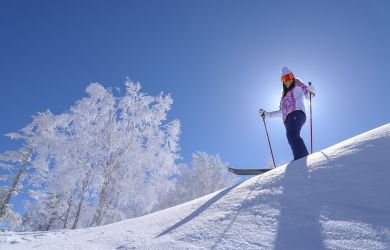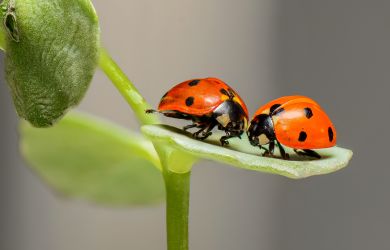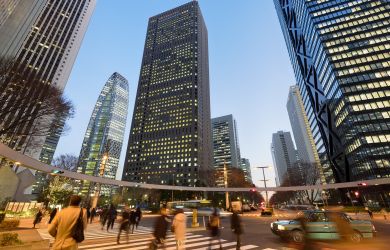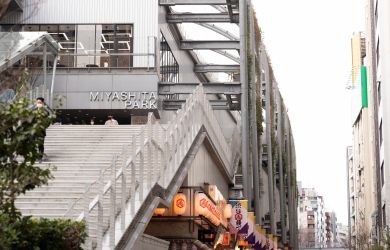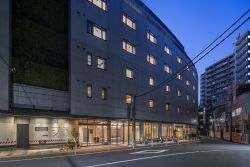
Originally published on metropolis.co.jp on August 2013
Ehime is one of four prefectures on the island of Shikoku in southwestern Japan. Shikoku means “four countries,” and today’s prefectures correspond to the four domains that existed in Japan’s feudal age. In feudal times, the area was known as Iyo, a word still found in many of its place names. Ehime is made up of the kanji for “love” and “maiden”—hinting at the kind of poetic tranquility found there.
Locals use a distinctive dialect, Iyo-ben, which chiefly consists of adding “ken” to most utterances, and replacing “so” with “ho.” So the standard Japanese phrase “so nan desu kedo” (“but anyway”) transforms into “hoya ken.” Pepper your speech with this phrase and people will soon think you are a native.
Matsuyama is the prefectural capital—a compact city centered around a dramatic hilltop castle. From the castle tower, gaze upon the Seto Inland Sea dotted with islands stretching into the hazy distance. On the other side, the city slopes gently up to the mountains. Just beyond the center is Dogo Onsen, said to be the first hot spring to be used for bathing in Japan. Dogo Onsen Honkan, the fabulous Meiji-era bathhouse, inspired one setting in Studio Ghibli classic Spirited Away. For a modest fee, take a dip in the venerable waters, and lounge afterwards in a stylish yukata sipping green tea.
The rural south of Ehime—known as “Nanyo”—looks much as it has for centuries, with ancient hamlets appearing at long intervals between river and mountains. But despite its apparent isolation, Nanyo residents have played a surprising international role in science and technology, as well as inventing the world’s first white candles—which stole the show at the Paris Expo of 1900. The more industrial east—or “Toyo”—features paper mills, factories of products like the prestigious Imabari Towel, and shipyards. Boat building isn’t commonly associated with beauty—but most people haven’t seen pristine vessels taking shape against a backdrop of bamboo groves around Ehime’s island shipyards.
Inland Islands

Ehime is part of the Setouchi region that borders the Seto Inland Sea, which became a National Park in 1934. The first visitors to Japan were struck by the extraordinary beauty of the shimmering sea dotted with pine-clad islands, some ringed with sandy beaches, others plunging straight into the water. Largely isolated for centuries, each island has its own character and customs—and many are home to some interesting art installations. Recently, some of them have been joined by bridges, notably the Shimanami Kaido. But otherwise, picturesque little ferries are the only way to get there. The Uwakai Sea facing southern Ehime also has its sprinkling of islands, where pearls are cultivated in the calm channels and protected coves. A stylish pearl accessory from Uwajima makes a great souvenir of a visit to this charming region.
http://en.japantourist.jp/city/uwajima
The Setouchi Shimanami Kaido International Cycling Preliminary Event will be held October 20, 2013. If you’d like to experience the thrill of riding in the race, apply here.
Iyo Suigun

Although the sea looks placid from afar, its unique underwater topography produces complex and rapid currents hazardous to unwary seafarers. Islanders used their intimate familiarity with the sea first to rob merchant ships, and later to control all seaborne traffic. Originating as pirates, they morphed into an armed coastguard, and later into a powerful regional government that maintained independence for centuries. Collectively, the various bands were called the Iyo Suigun (navy).
Their impact on Ehime can be seen everywhere—their crest of three wavy bars in a circle or hexagon is found on buildings and banners throughout the middle of the prefecture. The Murakami Suigun Museum on Oshima Island presents their ships, armor and culture in compelling displays. On the islands where they once built their wooden warships, shipyards today produce some of the world’s most advanced steel vessels.
http://en.japantourist.jp/view/murakami-suigun-museum
Culinary Culture

Ehime is an agricultural area with a mountainous interior and a long coastline. Its topography and mild, Mediterranean climate have spawned a sophisticated but wholesome culinary culture.
The powerful currents of the Inland Sea produce fish firmer, richer and sweeter than elsewhere—visitors are often surprised by how much nicer the sashimi tastes.
Although the region is one of the largest producers of citrus, farmers also grow excellent grapes, figs, and kiwifruit. Enjoy them as they are, or seek out the region’s innovative pâtissiers and brewers who work them into exquisite cakes and liqueurs.
Wild boar and pheasant are abundant in the mountains, and these game meats grace the menus of all styles of restaurant.
Ehime is also home to excellent sake breweries or sakagura. Nothing beats a visit to a rural kura to purchase a bottle under the old wooden beams.
Matsuyama Castle
Matsuyama Castle stands on a significant hill in the middle of Ehime’s prefectural capital, with an extensive moat and earthen ramparts that dominate the city center. Unlike many Japanese castles that were destroyed and rebuilt of concrete, Matsuyama Castle is still in its original state of wood and plaster.
As if the building itself and views weren’t interesting enough, a number of other things have been provided for your entertainment. You can dress up in a full set of replica armor, making yourself look like a rare giant insect, and fascinating exhibits show off armor, weapons and clothing.
A pleasant chairlift takes you to within a short stroll of the hilltop. Even if you don’t go inside the castle, there are fine views from the fortifications on top of the hill. In early spring, the castle grounds are pink with flowers, first of plum, then of cherry blossom.
Garyu Sanso Hermitage

This Meiji-period mountain hermitage was created by wealthy trader Torajiro Kochi when Ozu was a thriving center for paper and candles.
Kochi had extravagant ideas and the planning alone took ten years. The building’s design incorporated a large number of more or less eccentric demands—for example, that the light of the full moon reflected off the river should appear on the curved basketwork ceiling of a little annex. There are many visual puns, with names to match. Construction took four years—hardly surprising considering the intensive craftsmanship visible in every corner. Garyu Sanso was finished in 1907.
Staff are very friendly and will gladly show you everything, such as the “borrowed landscape” effect often seen in Japanese gardens, where distant mountains and rivers appear to be part of the garden.
http://en.japantourist.jp/view/garyu-sanso-an-architectural-folly-overlooking-hijikawa
Historic Streets
Uchiko is a small town that lies at the bottom of a river valley surrounded by spreading rice fields. Looking at this quiet, bucolic scene today, it’s hard to imagine the place was once an economic powerhouse, with a flourishing culture producing sophisticated architecture and arts.
Uchiko developed as a manufacturing center for paper and wax from the end of the Edo period to the end of the Meiji period. The main streets are lined with the extravagant premises that business families built as a mark of prestige. These feature white or yellow plaster walls, wooden or metal lattices, and decorative tiling and plasterwork.
The Uchiko-za theater is still used for kabuki and bunraku puppet performances. Along the streets are shops selling seasonal local produce, including the local huge sweet chestnuts. Eat in style in many of the cafés and restaurants, such as the historic Shimohaga-Tei restaurant.
http://en.japantourist.jp/view/uchiko-za-the-historical-kabuki-theater-in-uchiko
http://en.japantourist.jp/view/Shimohaga-Tei-restaurant


